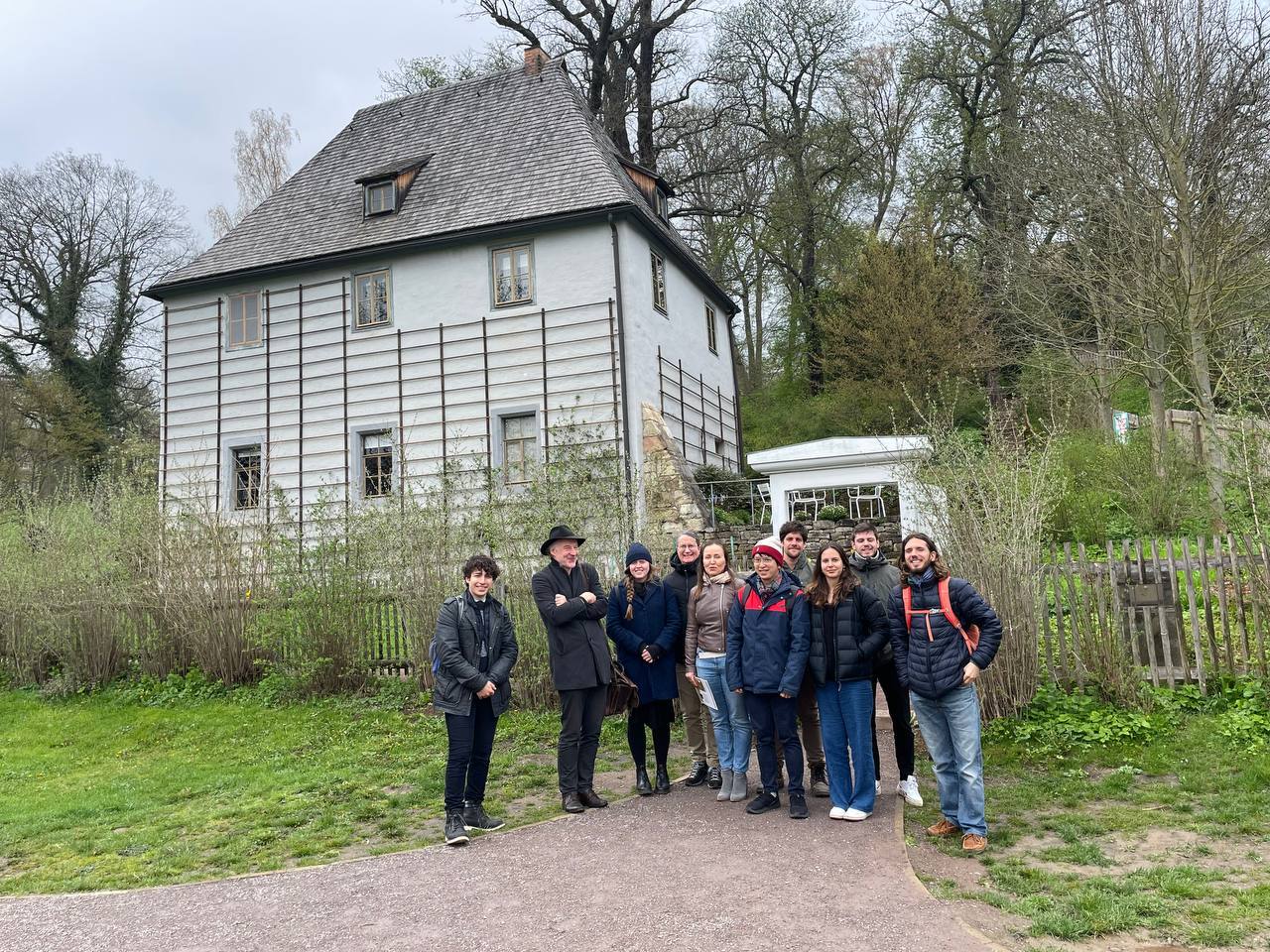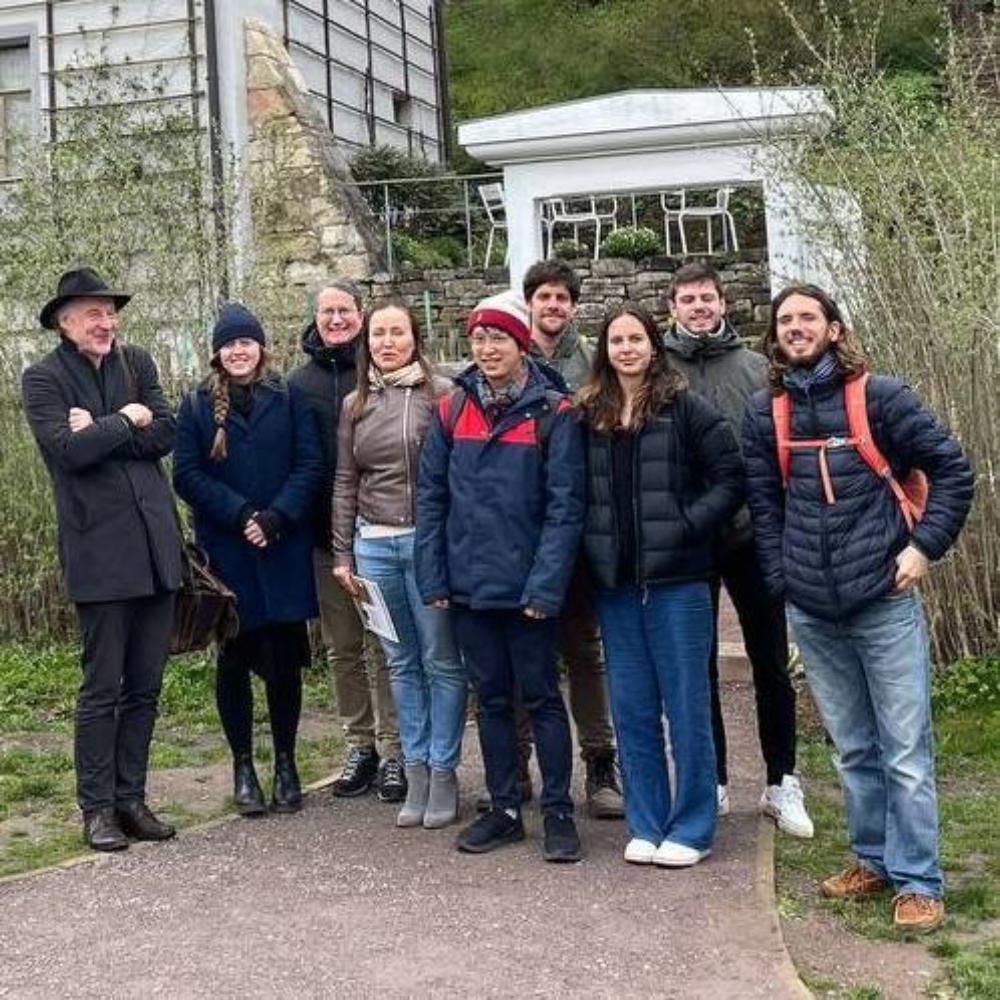The Drama of Weimar-Buchenwald
Prof. Dr. Peter Selg shares aspects of a seminar in Weimar-Buchenwald with the Students of the Anthroposophical Studies on Campus
Students from 11 countries have been taking part in the one-year anthroposophy course in English at the Goetheanum since the fall of 2022, as part of the "Study and Further Education" department of the General Anthroposophical Section. They come from far and wide, from Argentina to South Korea, to learn more about Rudolf Steiner's life work and his effectiveness in the world at the School of Spiritual Science in Dornach, Switzerland. Reading and teaching by Section leaders and staff of many departments of the School are at the center of the studies, scientific and artistic work.
With the financial support of the German Anthroposophical Society, we were in Weimar and Buchenwald from April 17 to 19, 2023 for an intensive seminar - in the houses of Goethe and Schiller, in the Nietzsche Archive, in the Buchenwald Memorial and in the rooms of the Anthroposophical Society and the Christian Community. The aim of the study visit was to gain a deeper picture of Rudolf Steiner's seven years of work in Weimar (1890-1897), in terms of content and context, and beyond that an understanding of this special city in the intellectual history of Germany and Europe - as well as an engagement with the Buchenwald concentration camp in close proximity. "K.L.. Buchenwald, Post Weimar" was the official name of the - incorporated - camp, whose commandant's office was easy to dial with the help of the Weimarer telephone book from 1937 on. A bus ran from Weimar's city center to the "Buchenwald (camp)" station, and no fewer than 40 Weimar companies and trades profited from the camp's lucrative contracts. More and more prisoners were part of work crews in the city, the prisoners were used in the armaments industry (Gustloff-Werke), on construction sites and in many small businesses and could be seen in the city every day. The Buchenwald concentration camp became, according to Peter Merseburger, "Weimar's twin place", in the middle of Germany, in full view of everyone, in public.

With the students the question was moved, how to understand all this - how could it come that in close proximity to a progressive artistic-spiritual center of humanism the exact opposite arose? Between 1937 and 1945, more than a quarter of a million people from 26 nations were imprisoned in Buchenwald, one in five of whom died. "Medical" human experiments, including vaccination experiments by the Robert Koch Institute in cooperation with German big industry and the SS, were carried out - with unimaginable cruelty. Was Buchenwald the consequence of Weimar, the monumental German classic, the heroic overestimation of the Germanic imperialism? Does a relationship of "resonance" (in the sense of Hartmut Rosa) exist here in the end and does Rudolf Steiner belong to a highly problematic line of German development, the line of "spiritual racism" (Staudenmeier) and hierarchical selection, as this is medially conveyed by critics of anthroposophy - and unsettles students of anthroposophy from all over the world?
The reality of life speaks of the opposite. If one studies the works that Steiner created in Weimar ("Truth and Science," "Philosophy of Freedom," "Friedrich Nietzsche. A Fighter Against His Time", "Goethe's Worldview") as well as the seven volumes of Goethe's Sophien-Ausgabe, which he published in Weimar from 1890 to 1897 with more than 3,000 printed copies, his commitment to a "different Germany" and a new natural science and humanities of a humanist character becomes apparent. The biography of Steiner's work, however, also shows the difficult position he had in Weimar, how the national-conservative musealization and instrumentalization of Goethe and Schiller was already being pursued there in the 1890s, and what resistance the "philosopher of freedom" had to face, despite his love for the city and his relationship to the intentions of the deceased.
When Rudolf Steiner wrote reminiscently about Weimar on his sickbed in 1924, National Socialism was beginning its triumphal march through the city, under Artur Dinter, the first National Socialist faction leader in the Thuringian state parliament, who gushed about the "Satanosophy" of the "Hungarian Jew Rudolf Steiner." Not only Steiner, but also the Bauhaus under Walter Gropius, which had attracted teachers such as Paul Klee, Wassily Kandinsky, Lionel Feininger and Johannes Itten since 1919, was to disappear from Weimar as part of the undesirable modernism. Adolf Hitler, who had just been released from prison in Landsberg, visited Weimar four times in 1925 - a total of 35 visits by him to the city are recorded up to 1939. In 1926, the first Reich Party Congress of the NSDAP took place in Weimar's National Theater, with Adolf Hitler, Heinrich Himmler, Joseph Goebbels, Alfred Rosenberg, Julius Streicher, Rudolf Heß, Wilhelm Frick and Bernhard Rust, who later closed Waldorf schools as Reich Minister of Education. Weimar was to provide the "Third Reich" with its cultural legitimacy and to concentrate the inner "enemies of the people" in a model camp - in complete alienation of what had been cos- mopolitically predisposed in this place in the 18th and 19th centuries.Our seminar was about this drama in the Michaelic "age of extremes" (according to the British universal historian Eric Hobsbawm) - and about the forces of resistance in the name of humanity. These forces existed even in the Buchenwald concentration camp. Among the resisters of the camp was the blind Jacques Lusseyran, who carried anthroposophy and the Goetheanum in his heart.We are very grateful for the support of the Anthroposophical Society in Germany!
Prof. Dr. Peter Selg, Faculty member, Anthroposophy Studies on Campus

